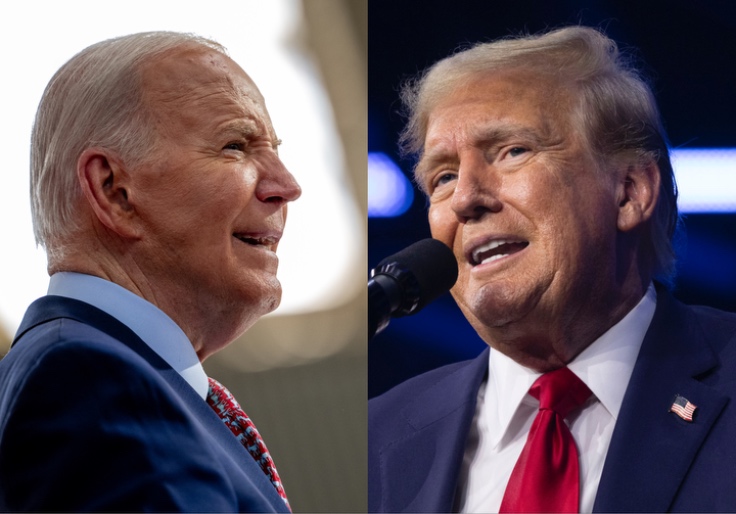Column: The malleable middle will decide Joe Biden’s fate—and Donald Trump’s

I’ve always been partial to the theory that a candidate or party that wins independent voters will win an election. And if independents are key, then the Trump campaign may want to keep a close eye on recent polling.
So far in the 2024 campaign, Donald Trump has enjoyed consistent support from independents despite losing their votes by 13 points in 2020. For example, the April New York Times/Siena poll had Trump winning likely voters overall by 1 point and likely independent voters by 4 points. The April Fox News poll of registered voters had Trump winning registered voters overall by 1 point and independent voters by 2 points.
The same pattern is visible in the states. The May Bloomberg/Morning Consult poll of swing states had Trump winning independents and sweeping every battleground except Michigan. And the June Emerson poll of swing states has Trump winning independents, and registered voters overall, in every swing state from Arizona to Pennsylvania.
But the Emerson poll also found that independent support for Trump has dropped. He’s below 45 percent among independents in Arizona, Michigan, and Pennsylvania. That is enough to beat Biden, for now. It’s not enough to put this election away.
Trump also lost support from independents in the June Fox News poll. In a wild swing, independents have gone from favoring Trump by 2 points to favoring Biden by 9 points, giving the incumbent a 2-point lead among voters nationwide.
These numbers suggest that Trump’s felony conviction in New York City hurt his lead. Trump is still ahead in the swing states, where the election will be decided, but in most cases his margins are tight. His ability to win back support from independents will make the difference.
After all, the presidential candidate or political party that won independent voters has won the White House or the House of Representatives in 7 of the past 10 biannual elections.
The exceptions were in 2004, when John Kerry won independents 50 percent to 48 percent but lost to George W. Bush, and in 2012, when Mitt Romney won independents 50 percent to 45 percent but lost to Barack Obama.
The national exit poll from 2022 helps explain why that midterm election was a disappointing year for the GOP. The poll had Democrats winning independents 49 percent to 47 percent while losing control of the House. At the state level, independents rejected Trump-selected candidates such as Kari Lake and Blake Masters in Arizona, Mehmet Oz in Pennsylvania, Herschel Walker in Georgia, and Tudor Dixon in Michigan. And what looked like an approaching red wave barely arrived on shore.
Republicans want to avoid a repeat in 2024. They have benefited from the public’s widespread and enduring disapproval of Biden. Independent voters disapprove of Biden’s economic performance, his handling of immigration, and his foreign policy. They share the larger public’s concerns about Biden’s age and infirmity. If the election were decided by job performance, policy prescriptions, and personal attributes, then Trump would win handily.
What we’re seeing is that independent voters may be having second thoughts about Trump’s character and personality. There are two ways Trump can address their fears. He can focus on inflation, immigration, and foreign policy during next week’s debate, and remind voters that they prefer the Trump economy, border, and world scene to present conditions. And he can choose a vice-presidential nominee who will reassure independent voters, not frighten them.
There is a long running debate in the Beltway about how elections are won. Is it better to mobilize your base, or should you persuade the middle? Which cohort matters most: committed partisans or self-identified independents?
Committed partisans receive most of the attention. The United States is a deeply and narrowly divided country. Turning out enthusiastic supporters is essential to victory. In 2004, a state constitutional amendment banning same-sex marriage in Ohio brought evangelical Christian and other values voters to the polls, helping George W. Bush win the state and a second term.
In 2012, African-American voters turned out in great numbers to reelect the first black president. In 2016, Donald Trump’s enthusiastic fanbase propelled a man with no government or military experience to the Republican nomination and then to the White House. And in 2020 that same fanbase organized boat parades and automobile and truck convoys that carried Trump to the brink of a second term. In business, entertainment, media, and politics, the superfan rules.
But he also needs help. The superfans were there for Trump in both 2016 and 2020. Independents were not. The independents backed Trump 46 percent to 42 percent when Hillary Clinton was on the ballot, then swung hard against him and the GOP in 2018 and 2020, and against MAGA diehards in 2022. To win in 2024, Trump must keep independents convinced that Joe Biden is a failed president.
How? Stay on message. Stick to the economy and the border. Be a party leader, not a factional leader. Keep the focus on Biden, and Biden will lose.
Original News Source – Washington Free Beacon
Running For Office? Conservative Campaign Management – Election Day Strategies!
